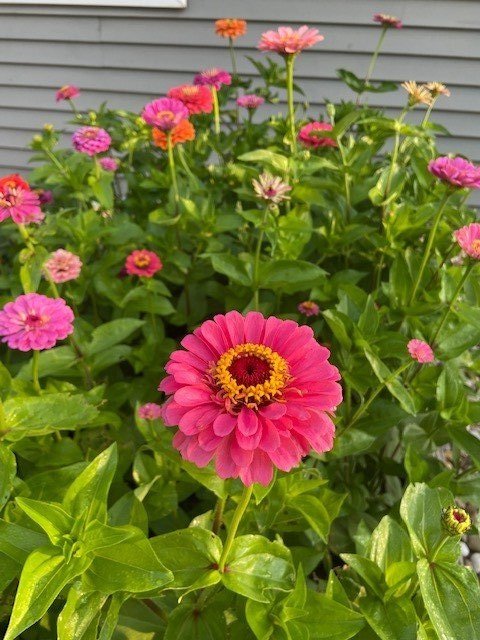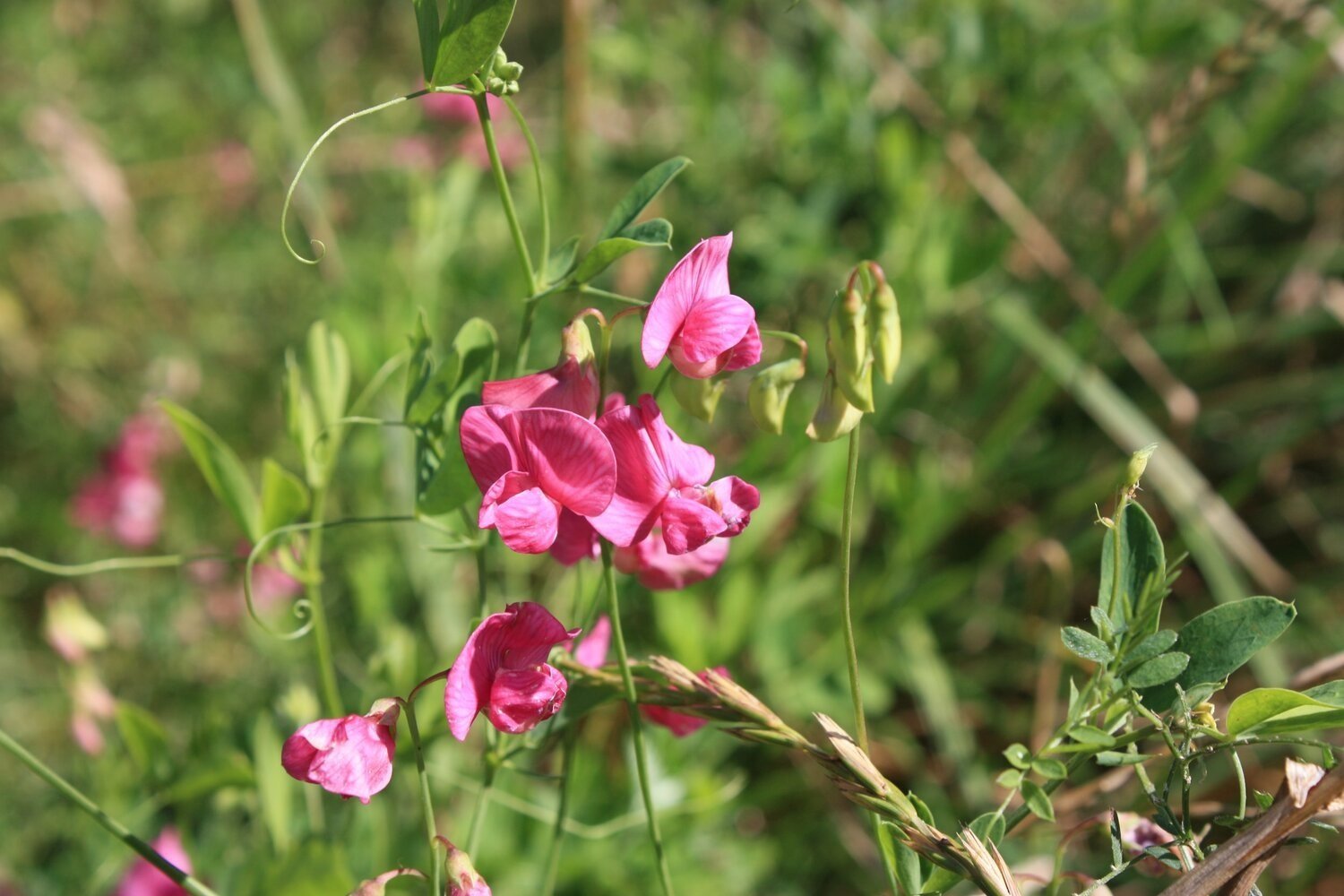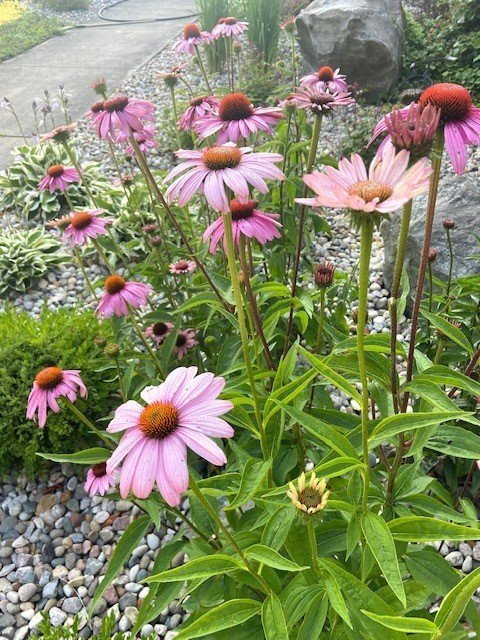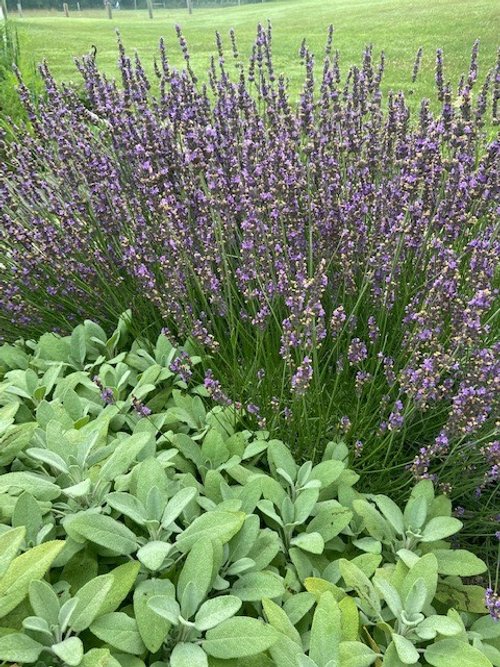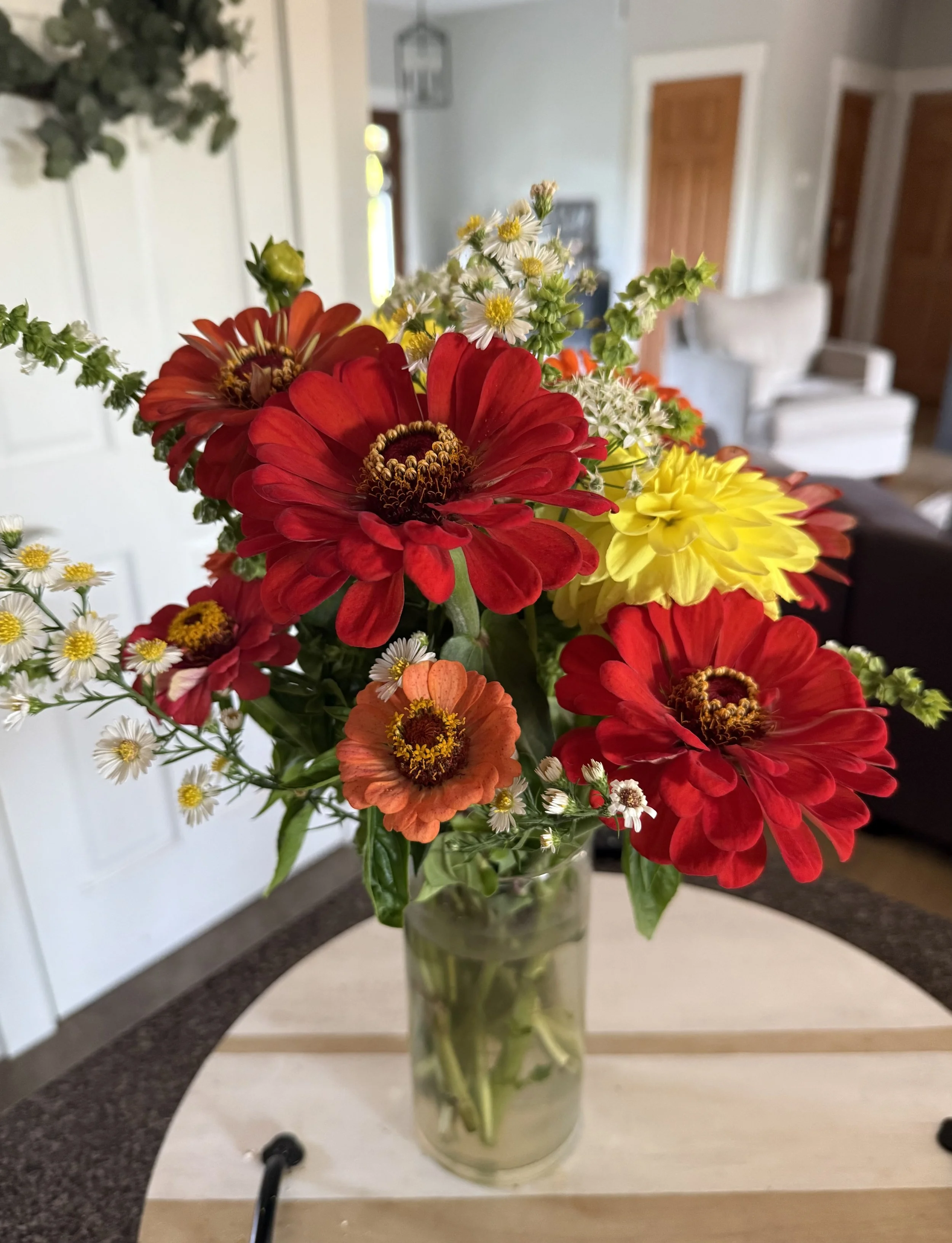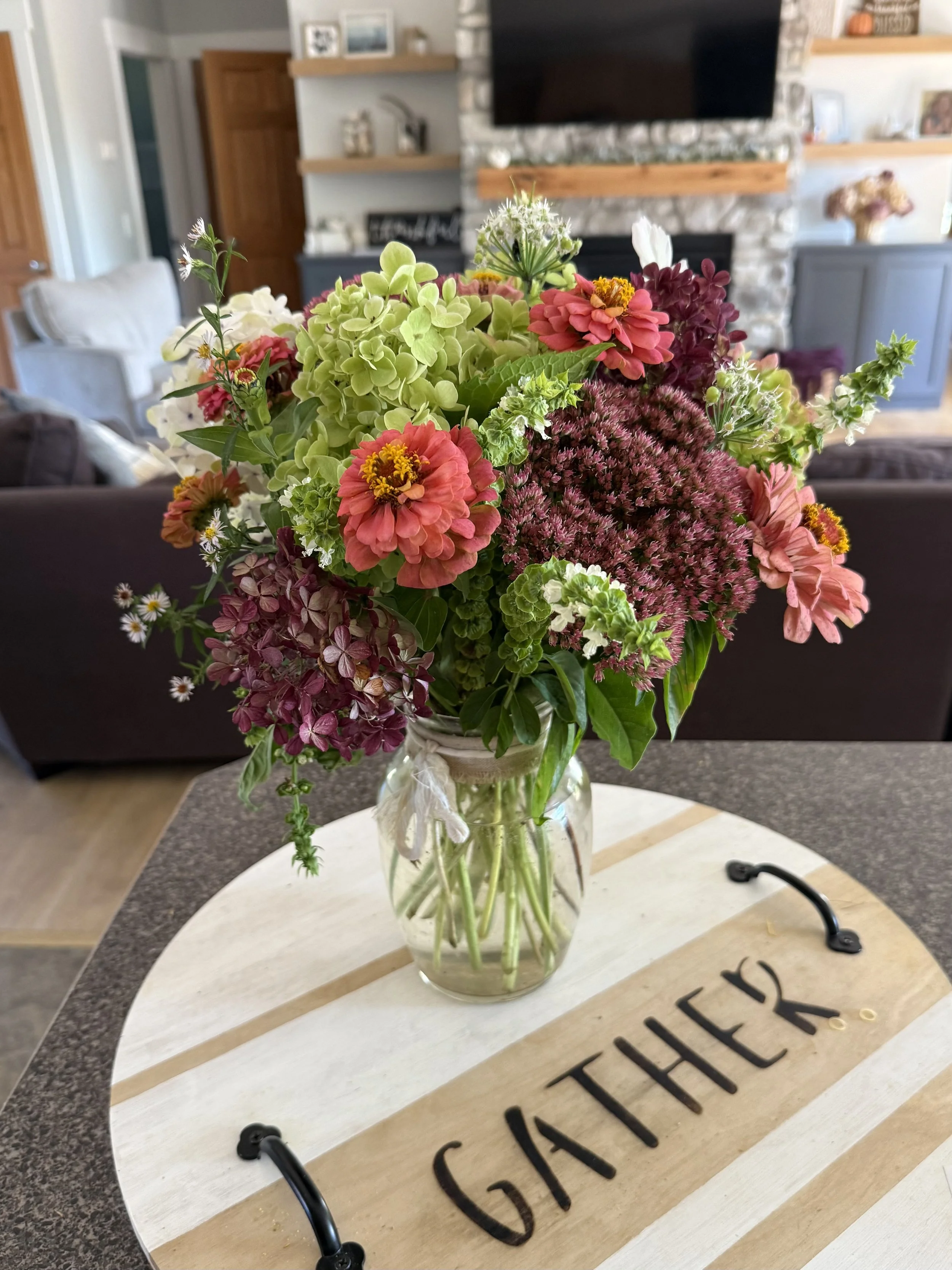Starting a Cut Flower Garden: Beginner’s Guide
A Beginners Guide for Starting a Cut Flower Garden
Flowers have the power to bring joy to recipients, evoke memories from a single familiar smell, and foster a greater appreciate for nature. I LOVE flowers and I’m guessing that you enjoy them too, especially if you’re contemplating growing a cut flower garden.
Mixed bouquets of zinnias, coneflowers, snapdragons, lavendar, yarrow and dahlias
I’ve always enjoyed clipping fresh lilacs and hydrangeas from my landscape. Although three years ago I began growing annual flowers with my four children specifically for cutting to create bouquets.
While working at my family’s nursery, I grew up with a basic plant knowledge. I also gleaned information from online, from friends, family and through trial and error over the years.
No matter your previous gardening experience, I’m sharing some great plants to start off incorporating into your yard. Below you will find the easiest flowers to grow for kids and beginners. Even if you’re a novice or lack a green thumb, these hardy plants will do well.
Quick Tip: This is a great time to purchase a sturdy watering can, gardening gloves, kneeling pad, seed packets or a gardening kit for your outdoor loving kids as Easter Basket Fillers.
For reference, I live in Southwest Michigan in zone 6. The pictures of flowers and bouquets shared are from my own garden, flower beds and landscape.
Zinnias are easy to grow annuals
This post may contain affiliate links that add no additional cost to you, I may earn a small commission to help offset the cost of my blog.
What is a Cut Flower Garden?
If you’re a complete newbie, you make be asking what is a cut flower garden? Cut flower gardens are grown specifically for cutting and creating bouquets or arrangements. The flowers are selected based on their bloom time, size and color. Ideally they have long stems and maintain a long shelf life in a vase. They are generally a mix of annuals, perennials, flowering bushes, and filler plants. Purposefully choosing a wide variety of flowers with differing bloom times will allow you to enjoy bouquets throughout the growing season, including spring, summer and fall.
If you don’t have a ton of space, try integrating your plants and flowers into your landscape, vegetable garden or along a fence. Choosing perennial plants and bushes that produce lovely floral blooms is a simple way to have access to flowers to brighten any space.
Tips for Planting and Growing a Cut Flower Garden
Choose a sunny spot for your garden.
Always start with a good base. Choose a sunny location and rich soil with nutrients. Adding organic matter including compost, leaf litter, and composted manure will add nutrients to the soil and assist with proper water retention and drainage. We utilize an outdoor tumbler compost bin and an indoor odorless compost bin for our kitchen scraps, which has made composting simple and easy. If you don’t have those resources, choose a good quality potting soil to mix into your garden area.
Some flowers benefit from pinching. Pinching is essentially cutting off part of the plant when it is young. Snip off directly above the 2nd or 3rd leaf, which promotes the plant to produce more stems and in turn rewards you with a stronger plant and produces more blooms. (Zinnias, Cosmos, Snapdragons, and Sweet Peas all benefit from pinching)
Ideally water early in the morning at the base to avoid fungal diseases.
Some flowers may need support, such as staking, netting, or corralling.
Three Types of Flowers for your Cut Flower Garden
To simplify it’s ideal to have three types of flowers to gather from for creating floral arrangements.
Annuals (Plants which need to be planted each year or annually) Annuals only last one growing season so they need to be planted each year. The perk is that they typically have a much longer blooming period.
Perennials (Plants that come back every year in the spring) Perennials typically have a shorter blooming period as compared to annuals, but will return each year. Check out our list of the best perennials for cut flowers.
Fillers These are plants, flowers and greenery that can be used to make a bouquet full. It can include ornamental grasses, fragrant herbs like basil, raspberry leaves, hostas, foliage from bushes or bunches of smaller flowers
Easiest Annual Flowers to Grow for Beginners
Zinnias
These bright, colorful flowers in shades of pinks, oranges, yellows and whites are ridiculously easy to grow and are my top pick for children and beginners. They have long sturdy stems and an extended vase life. Try the California Giant Zinnias for large focal point blooms.
Sunflowers
These cheery, quintessential summer flowers are easy to grow, especially in the hot heat of the summer and require minimal attention to thrive. Plus, there are tons of different varieties from bright yellow, fridge burgundy, and large doubles. Try a dark chocolate ones for deep burgandy blooms.
Cosmos
With airy fernlike leaves and summery shades of pink and white flowers Cosmos are great for beginners. Plus the more you cut, the more they produce lovely blooms. They thrive in full sun and well drained soil. Last year, we tried and loved the mixed double bloom varieties.
Sweet Peas
In spite of their delicate look, Sweet Peas are rather hardy. They add a light, whimsical addition to any vase. Plus their delicious scent will be delightful in your garden. If you live in a colder zone, starting seeds indoors is best due to their longer germination period. They grow best on a trellis so they work well in small gardens with limited space.
Other Annuals to Consider: Strawflower, Snapdragons, Celosia (Cocks Comb)
*One other flower I want to add is Dahlias, although they require some additional work they are simply gorgeous.
Dahlia
Dahlias
Technically, Dahlia plants are tubers. So you’re looking at a higher up front cost than seeds, but these show stopping blooms our a favorite and make a wonderful focal piece of any bouquet. Choose varieties that have a long stem and height. Plant dahlia tubers after the last threat of frost. Similar to many cut flowers, they do best in full sun and well-drained soil. If you want to have Dahlias for the next season (zones 3-6) there is some additional work. Dig up tubers at the end of the season, store in a dry place over winter and replant in spring after the last frost.
Perennials to Add to Your Yard for Cut Flowers
Investing in perennials is a wonderful addition to your yard, and you will reap the bountiful harvest years to come. Although the initial cost up front is more than annual seeds, these beauties will continue to produce exquisite blooms year after year making them an investment.
To cut down on the cost start adding a few new plants each year from a local nursery. Many perennials like iris, hostas, and lilies do best when they are divided after several years so they don’t become overcrowded.
Another option is to swap plants with neighbors or friends. As your confidence grows, you can experiment with new plants and learn their specific nuisances and requirements. In addition, continually selecting perennial plants and bushes will add dimension and beauty to your backyard.
Cone Flower
With strong sturdy stems and unique cone shaped centers, they add a ton of texture and interest to bouquets. I especially love the purple coneflower and white coneflower.
Hydrangeas
One of my all time favorite flowering bushes is the hydrangea, which produce lovely full blooms. The stunning blushing bride hydrangea shifts from white, to pink and then fades to a dark rusty, pink color. It prefers part shade and moist well drained soil. Late in the season it can be used to make a great dried flower arrangement.
Peony Bushes
These stunning beauties need no explanation, with enormous blooms that make the loveliest bouquets, they will soon become a favorite in your home. They love full sun areas. Staking may be needed due to the large, heavy flower blossoms. An ideal spot in a yard is alongside a fence rows to help support them.
Hydrangea
Yarrow
Yarrow’s cluster-like flowers come in lots of different colors and makes a great filler. They thrive in full sun and dry conditions. I personally appreciate the white because they go with any color scheme, but they also come in tons of pastel colors too.
Autumn Joy Sedum
This late season, rosy bloomer pairs beautifully with sunflowers. Adding the green florets to vases is a wonderful filler even before they begin to produce pink flowers. They can tolerate drought like conditions and full sun so little maintenance is required.
Lavender
Ahhh…adding lavender to any bouquet adds a relaxing scent and height to any bouquet. The long purple blooms prefer a sunny site with well drained soil.
Basil
This fragrant herb is ideal in the kitchen and for bouquets, basil-with its green stems and small white flowers make ideal fillers for any bouquet.
Tips for Harvesting Flowers from Your Cut Flower Garden
Bouquet of Zinnias, Basil, Dahlias, Wildflowers
Tulips are bulbs that return each spring
Ideally gather flowers in the early morning or later evening when temperatures are cooler. Avoid the hot, heat of the day.
Collect your flowers in a bucket or vase full of cool water so they can immediately start absorbing liquid.
Use a sharp, clean pair of gardening shears or scissors. Cut the stems at an angle, keeping a long length of stem. Later, you can always recut them once you’re arranging the vase. I recommend utilizing these gardening shears for nice clean cuts.
Select flowers that have just begun to open for a longer vase life.
A common mistake many people make is not adding greenery or fillers to their bouquets. Consider adding foliage from shrubs, bushes, herbs, hosta leaves and grasses from around your yard. They can often add interest and fill out a bouquet. Utilize fields or wildflowers by your home too. For example we love adding Queen Anne’s Lace and cat tails to bouquets for some variety.
Another source is adding herbs to the mix, especially scented ones like lavender and basil, which produce a lovely fragrance in arrangements. Don’t be afraid to experiment by adding different plants around your yard to create one-of-a kind bouquets.
Tips for Making Cut Flowers Last Longer
Now that you have selected your flowers from the garden, you’re ready to start arranging them in a vase. Here are simple steps to help extend the life of your flower bouquet.
Strip all the leaves off the lower part of the stem that will be submerged in water. (The purpose is to avoid the leaves rotting within the water.)
Cut the stems again at an angle to allow for greater water absorption.
Sprinkle Cut Flower Food, into the vase of water.
Freshly cut flowers suck up a ton of water so monitor the water level in the vase, especially on the first day.
Change the water daily or when it becomes murky.
When changing the water, re-cut the ends of the stems and sprinkle in cut flower food.
Continuously remove flowers or leaves that are spent.
Downsize to a smaller vase when your bouquet gets smaller, especially as you remove spent blooms.
Zinnias, Dahlias, Cosmos Cut Flower Bouquet
Benefits of Planting a Cut Flower Garden with Kids
Children adore growing plants from seeds. Even as an adult, I love the excitement and magic of witnessing the first green shoots breaking through the soil. Involving your children from the very first planted seed to harvesting and arranging flowers in a vase gives them a sense of pride, plus there are tons of other benefits they reap. Another reason we started our garden was a desire for my family to spend more time outdoors while participating in the 1000 Hours Outside Challenge.
Hydrangeas, Zinnias, Basil, and Sedum
Gain numerous health benefits while being outside in nature.
If you grow a vegetable garden, flowers attract bees which helps spread pollen and fertilize your vegetables, thus increasing your harvest.
Saves you money if you often buy bouquets for your home.
Teach your children patience and delayed gratification while growing flowers, which is crucial in an age where everything is instant.
Fosters responsibility in children by requiring planting, weeding, watering and harvesting.
Provides an opportunity to bless others. (Throughout the summer, our family randomly chooses friends and family to encourage with a vase of cheerful flowers.)
Essentially you have an Earth Science mini lesson every time you get outside in the dirt. Plus, you’ll learn hands on about each plant’s unique growing environments and needs.
Flowering bushes, perennials and annuals add beauty to your backyard space.
Closing Thoughts
Being able to enjoy fresh cut flowers directly from the garden is a lovely way to bring a little color inside your home. We hope this information has provided inspiration, instructions and the best tips for creating your very own cut flower garden.
Cut Flower Home made Stand
Who knows, maybe you’ll even start a flower stand. My 4 children have helped me set up a simple roadside stand to share our flowers and extra veggies with the community. We leave out a tip jar for donations and my children enjoy earning money from their hard work. Fresh cut flowers are a quintessential addition to brighten any space or anyone’ day. By starting your very own cut flower garden you can enjoy them all summer long.
I’m thrilled you stopped by Discovering Anew today! Make sure to Pin and Save for later. So I’m curious, do you have a cut flower garden at your home or do you simply cut flowers from your landscape? Please leave a comment and share with me what is your personal favorite flower?
Follow me on Pinterest for more outdoor activities and crafts ideas. Our family loves adventuring and sharing trip guides as we explore the Midwest camping, hiking and discovering local gems.
Feature Articles you May Enjoy
Children’s Pictured Books Inspired By Nature, Camping and Hiking
25 Ways to Make the World a More Beautiful Place: Inspired by Miss Rumphius








